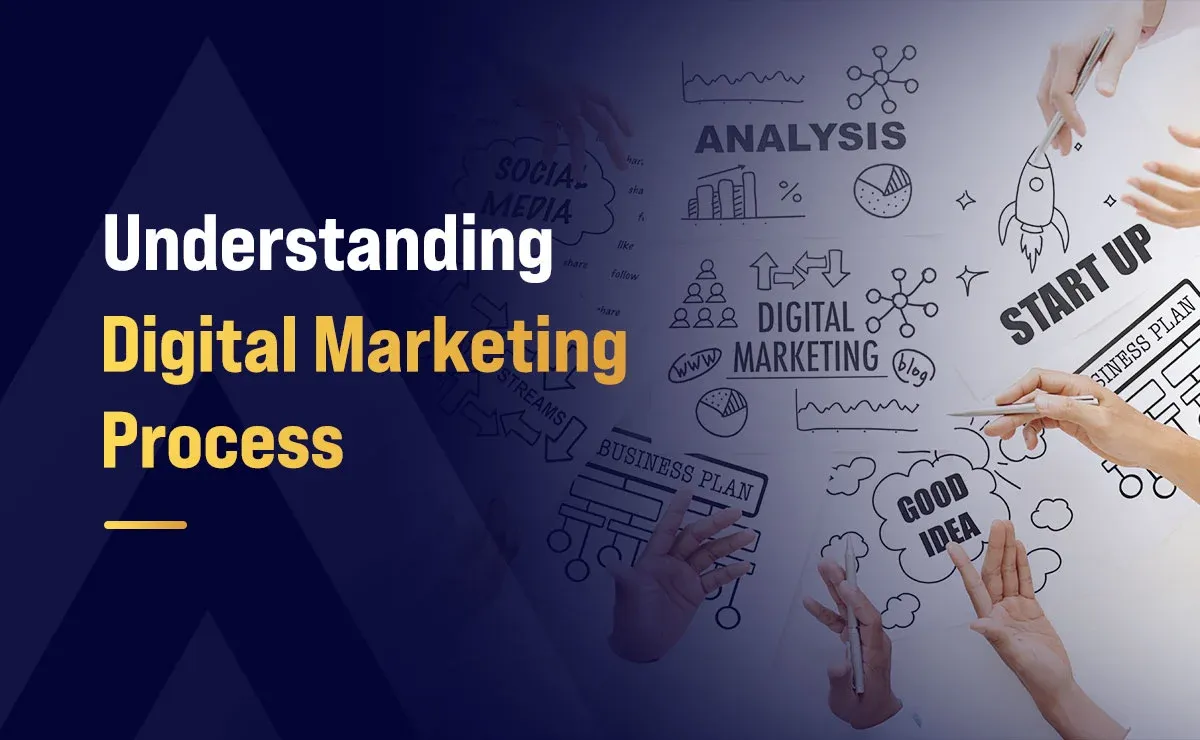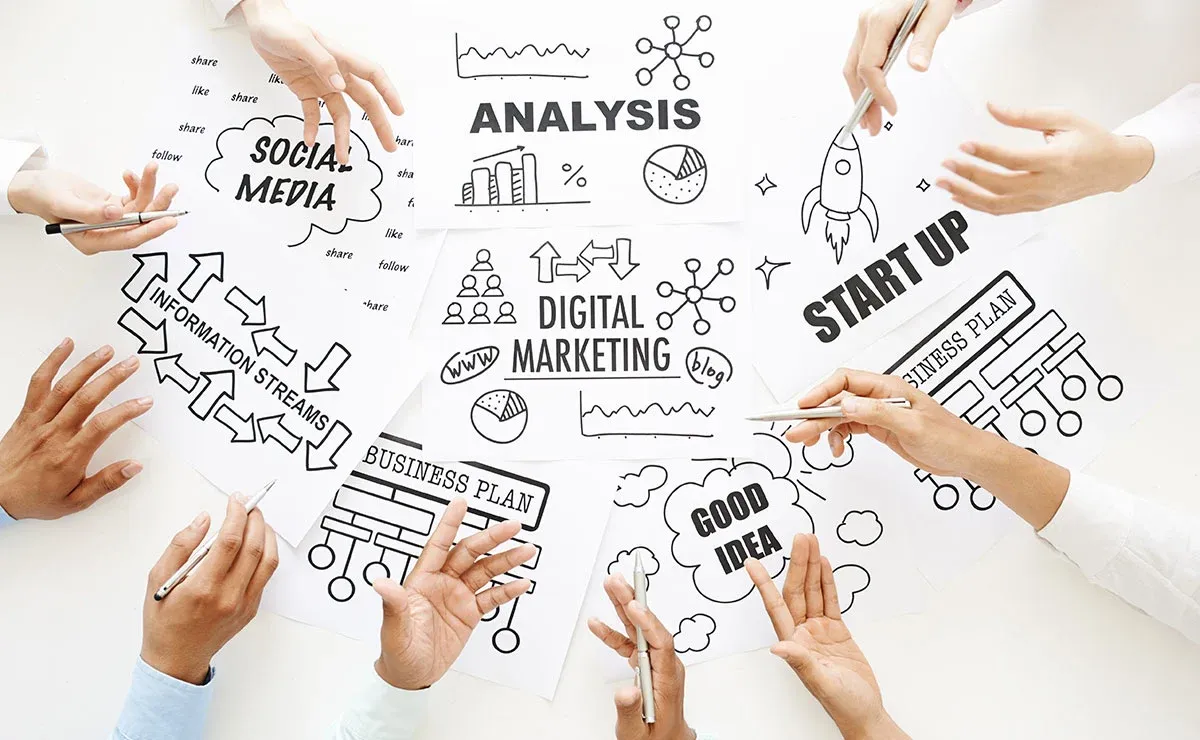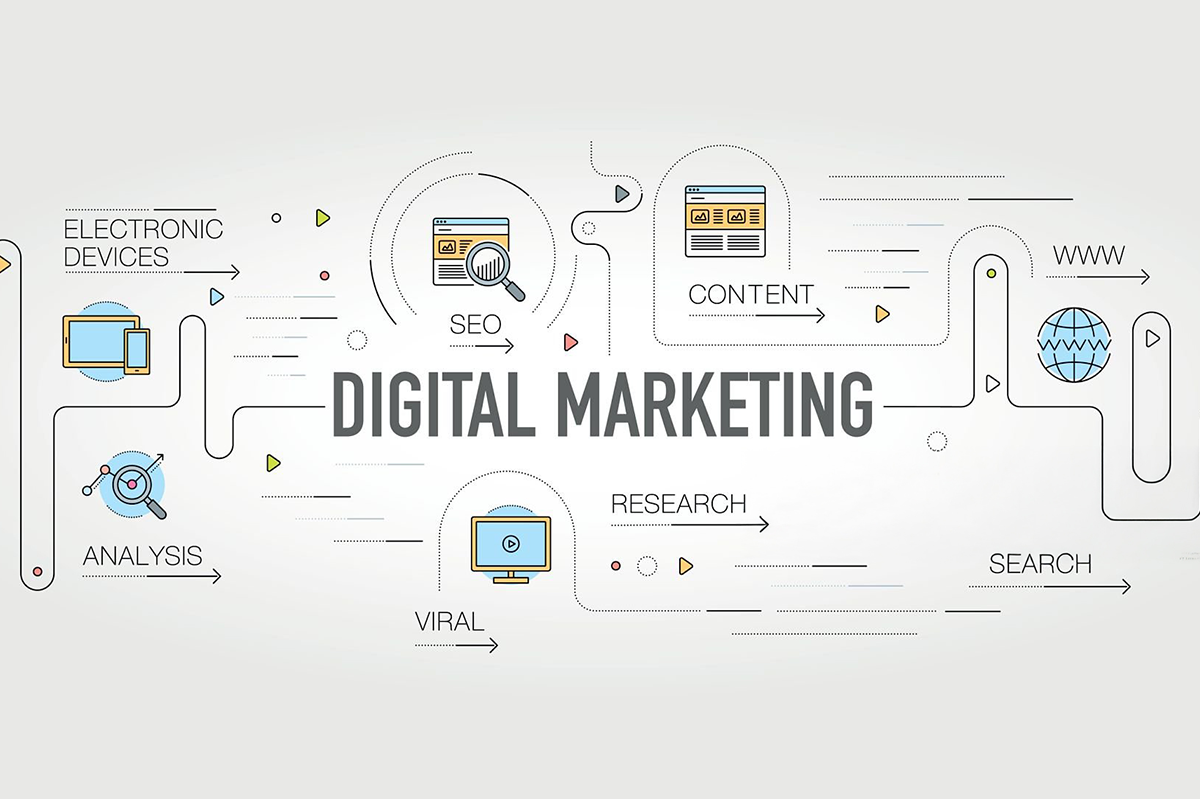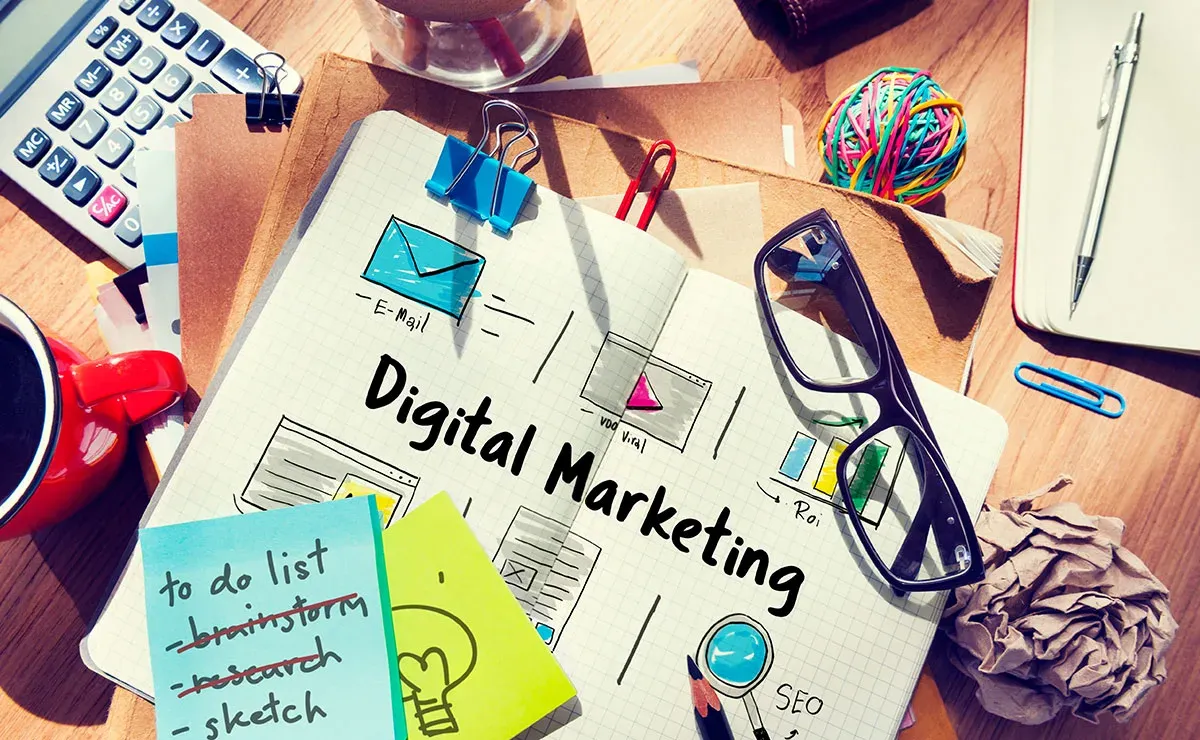Understanding Digital Marketing Process

Effective digital marketing requires strategic content deployment rather than randomly publishing and expecting results. It's about following a systematic process that turns visibility into revenue. With the global digital marketing market projected to reach $1.3 trillion by 2033, businesses that master the digital landscape will thrive, while those who ignore it risk becoming irrelevant.
But here's the challenge: only 7.7% of company revenue is typically allocated to marketing efforts. This means every dollar must work harder and smarter. Let's examine the digital marketing process through concrete phases, supported by tested methodologies.
A Step-by-Step Digital Marketing Process
The digital marketing process consists of five key steps:

Research
Before starting any marketing campaign, research is the foundation that helps in making informed decisions. This stage involves:
- Business Analysis: Understanding the company's vision, mission, products, and services.
- Targeting Audience: Identifying demographics, interests, behaviors, and pain points of potential customers.
- Product/Service Insights: Evaluating the Unique Selling Proposition (USP) and market demand.
Research generates crucial intelligence that informs every aspect of a digital campaign's development.
Create
Following thorough investigation, it becomes necessary to formulate an organized strategy like:
- Setting SMART (Specific, Measurable, Achievable, Relevant, Time-bound) goals.
- Planning the branding, content, and advertising approach.
- Documenting detailed campaign activities and timelines.
- Creating essential online assets such as:
- Website
- Blog
- Mobile App (if required)
A strong foundation ensures that the business is well-prepared before launching promotions.
Promote
Promotion represents the stage where organizations begin attracting qualified visitors to their online destinations. This is done using various digital marketing channels, including:
- Search Engine Optimization (SEO): Improving organic search rankings on Google.
- Search Engine Marketing (SEM): Deploying paid advertisements through Google Ads.
- Email Marketing: Delivering customized messages to connect with and maintain clientele.
- Affiliate Marketing: Collaborating with influencers and marketers to advocate for products.
- Social Media Marketing (SMM): Promoting content on platforms like Facebook, Instagram, LinkedIn, and Twitter.
Through strategic channel utilization, companies can enhance their digital presence and draw potential buyers.
Analyze
Once marketing initiatives are activated, monitoring performance becomes vital. Essential metrics to track include:
- Website Traffic: Employing Google Analytics to monitor visitors and their interactions.
- Conversion Rates: Calculating the proportion of visitors who complete intended actions (purchase, sign-up, etc.)
- Audience Engagement: Assessing social media interactions, email open rates, and ad performance.
Data examination helps marketers identify successful elements and areas requiring enhancement.
Optimize
The culminating phase involves enhancement, which entails implementing evidence-based modifications to boost effectiveness. Areas for optimization include:
- Website UI/UX: Enhancing design and navigation for better user experience.
- SEO Improvements: Updating keywords, content, and backlinks.
- Ad Performance: Adjusting ad copy, audience targeting, and budget allocation.
- Social Media Strategy: Refining content types, posting schedules, and engagement tactics.
Continuous refinement guarantees that digital marketing initiatives stay productive and deliver peak return on investment.
Different Types of Digital Marketing
Let's explore a few essential types of digital marketing processes and how they work together to create a successful online presence.

Affiliate Marketing
Affiliate marketing, also known as influencer marketing, is a performance-based strategy where businesses partner with affiliates (third-party promoters) to market their products or services. These promotional partners receive commissions for each transaction or prospect generated through their specialized referral links.
The worldwide affiliate marketing platform industry is expected to attain an impressive US$ 39805.4 million by 2031, expanding at a CAGR of 7.9%.
How It Works:
- A business creates an affiliate program and provides affiliates with custom referral links.
- Affiliates promote the product/service via blogs, social media, YouTube, or websites.
- Prospects select affiliate hyperlinks and complete transactions.
- The partner earns compensation, while the business acquires new patrons.
Key Benefits:
- Cost-effective: Businesses only pay for successful conversions, reducing financial risks.
- Expands reach: Affiliates have their own audience, helping brands access new markets.
- Establishes credibility: Influencers generate authentic content that connects with their audience.
Content Marketing
Content marketing concentrates on producing valuable, applicable, and informative material to engage and retain target demographics. According to HubSpot, approximately 29% of marketers actively implement content marketing as a digital strategy. Unlike conventional advertising, it aims to enlighten, inform, or amuse rather than explicitly promote products.
How It Works:
- Businesses create blogs, videos, e-books, whitepapers, infographics, and podcasts.
- Content is distributed across websites, social networks, and email campaigns.
- High-quality content improves SEO rankings, driving organic traffic to a website.
- Engaged users develop trust in the brand, increasing the chances of conversion.
Key Benefits:
- Enhances SEO and Drives Organic Traffic: Optimized content improves search engine rankings, increasing visibility and attracting more visitors.
- Establishes Brand Credibility: Premium, thoroughly researched content establishes your organization as a respected industry expert.
- Fosters Long-Term Customer Relationships: Engaging and valuable content cultivates loyalty, keeping customers connected to your brand over time.
Email Marketing
Email marketing remains one of the most cost-effective and high-conversion digital marketing strategies. As almost 4.5 billion people use email worldwide, for every $1 spent on email marketing, the average return is $36, delivering a 3600% ROI. It encompasses sending tailored messages to subscribers to cultivate prospects, showcase products, and sustain customers.
How It Works:
- Businesses collect email addresses through sign-ups, gated content, or promotions.
- They create personalized email campaigns using segmentation and automation tools.
- Emails include newsletters, promotional offers, educational content, or surveys.
- Analytics monitor message opening frequencies, click-through percentages (CTR), and conversions to enhance effectiveness.
Key Benefits:
- Highly Targeted: Emails can be tailored to individual preferences and behaviors, ensuring relevant and personalized communication.
- Cost-Effective: Generates exceptional investment returns (ROI) when compared with conventional paid promotions, establishing it as a budget-conscious strategy.
- Builds Stronger Customer Relationships: Keeps your brand top-of-mind, helping to retain existing customers and re-engage those who may have drifted away.
Marketing Analytics
Marketing analytics forms the foundation of digital marketing, enabling businesses to monitor, assess, and refine their initiatives. It involves collecting data from various sources to make informed marketing decisions.
How It Works:
- Marketers utilize tools like Google Analytics, social platform insights, and CRM applications to evaluate performance.
- Indicators such as site visitation, conversion percentages, customer activities, and engagement are evaluated.
- This information is utilized to enhance marketing approaches, boost ROI, and perfect advertisement targeting.
Key Benefits:
- Consumer Insights: Provides valuable data for deeper comprehension of audience patterns and preferences.
- Optimizes budget allocation: It helps pinpoint top-performing campaigns while ensuring that resources are strategically allocated for maximum ROI.
- Enhances personalization: Enables organizations to design customized marketing interactions that connect with individual consumers.
Mobile Marketing
With over 700 million smartphone users in India, mobile marketing is crucial for reaching audiences on mobile devices through SMS, push notifications, mobile-friendly ads, and apps.
How It Works:
- Businesses use location-based marketing to send relevant promotions when a user is nearby.
- Mobile-optimized websites guarantee a fluid experience across different devices.
- App-based marketing includes in-app advertisements, notifications, and SMS marketing.
Key Benefits:
- High Engagement: With users spending significant time on mobile devices daily, it offers a prime opportunity to capture their attention.
- Real-Time Marketing: Facilitates instant, timely interactions with potential customers, boosting responsiveness and relevance.
- Elevates Customer Experience: Mobile-optimized content ensures seamless navigation and satisfaction, enhancing overall user experience.
Pay-Per-Click (PPC) Advertising
PPC (Pay-Per-Click) advertising represents a paid digital marketing approach where companies pay a fee whenever a user clicks their advertisement. This approach is designed to drive instant, targeted traffic to websites, making it an effective tool for quick results.
How It Works:
- Organizations bid on keyword terms relevant to their offerings or services.
- Their promotions appear in search engine listings (e.g., Google Ads), social media platforms, or on affiliate websites.
- Marketers incur fees exclusively when individuals interact with their promotional materials.
Key Benefits:
- Immediate Results: Unlike organic techniques such as SEO, PPC delivers prompt visibility and traffic.
- Accurate Targeting: Advertisements can be customized to reach demographics based on population segments, geography, interests, and additional factors.
- Measurable Performance: Campaign performance and ROI are easily measurable, allowing for continuous optimization and better outcomes.
Search Engine Optimization (SEO)
SEO (Search Engine Optimization) encompasses the systematic enhancement of websites to boost their visibility in search engine results like Google, facilitating easier business discovery by potential clients online. Businesses that adopted SEO strategies experienced a 40% increase in organic traffic.
How It Works:
- SEO professionals conduct thorough keyword analysis to uncover search terms utilized by target audiences.
- They enhance website content, URL structures, and metadata to align perfectly with search engine requirements.
- Building backlinks from authoritative websites enhances the site’s credibility and ranking.
Key Benefits:
- Produces Organic Traffic: Unlike paid advertisements, SEO creates free, quality traffic to your website.
- Builds Brand Trust: Higher search rankings signal credibility and reliability to users.
- Enduring Results: Well-optimized promotional material continues to draw visitors over time, ensuring continued growth.
Social Media Marketing (SMM)
Social media marketing leverages digital communities such as Facebook, Instagram, LinkedIn, Twitter, and TikTok to engage with audiences and strategically promote brands. Social platform advertising investments are forecast to hit $276.7 billion by 2025, with mobile devices accounting for 83% of this advertising expenditure by 2030.
How It Works:
- Companies create and distribute compelling material, including text, images, and videos.
- They proactively interact with users through comments, direct messages, and real-time engagements.
- Paid social media advertisements are employed to target specific demographics, generating higher conversions.
Key Benefits:
- Broadens Brand Reach: Social media links businesses with an extensive, global audience.
- Boosts Engagement: Likes, shares, and comments increase visibility and foster community interaction.
- Enables Influencer Collaborations: Partnering with influencers amplifies brand credibility and reach.
Successful Digital Marketing Implementation Case Studies
Implementing the right digital marketing process can significantly impact a company's brand awareness, revenue, and overall growth. Let's explore a successful process of digital marketing with an example of a case study that showcases how well-planned and executed it can be to drive remarkable results.
Gump’s San Francisco: Achieving 92% Year-over-Year Sales Growth Through SEO and Cross-Selling
Challenge:
Gump’s, a specialty goods retailer selling home decor and jewelry, had a successful sales year in 2021. Instead of fixing problems, they wanted to push their success further in 2022 by surpassing their previous sales records.
The objective was to:
- Maintain existing customers while drawing new ones.
- Improve product descriptions to generate more organic traffic.
- Maximize revenue growth through Google Search and Shopping campaigns.
Strategy
To ensure success, the strategy focused on three key digital marketing processes:
- Cross-Selling and Retargeting: Encouraging existing customers to make repeat purchases.
- Google Search and Shopping Optimization: Ensuring product listings were SEO-friendly and competitive.
- Paid Advertising Expansion: Allocating resources to sponsored promotions across varied platforms to heighten exposure.
Execution
- Implemented Google Shopping ads to increase visibility of high-performing home decor products.
- Optimized product listings for search relevance and conversions.
- Focused on returning customers with individualized suggestions and exclusive offers.
- Expanded advertising efforts across Google, social media, and email marketing.
Results
- 92% Year-over-Year Sales Growth: Achieved a massive boost in total sales compared to 2021.
- 79% Increase in Revenue: Digital marketing efforts drove significant revenue growth.
- 40% More Website Traffic: SEO and Google Shopping ads brought in new customers.
- 104% ROI on Google Ads in the Home Decor Category: Optimized product listings doubled the return on ad spend.
- 32% Increase in Repeat Customer Rate: Cross-selling and retargeting strategies improved customer loyalty.
Crucial Tools & Resources for Digital Marketing Process
Addressing digital marketing challenges and achieving excellence depends on employing appropriate tools to streamline processes, improve engagement, and measure performance. Here are six fundamental tools every marketer should use:

Mailchimp (Email Marketing)
Mailchimp represents a robust email marketing platform that allows businesses to develop, automate, and evaluate email campaigns. With customizable templates, A/B testing, and audience segmentation, it’s a go-to tool for effective email marketing.
Hootsuite (Social Media Management)
Hootsuite allows you to schedule content, engage with followers, and measure campaign effectiveness across various social platforms from an integrated control center. It also supplies analytics and social listening capabilities.
Google Analytics (Web Analytics)
A must-have for tracking website traffic and user behavior, Google Analytics provides insights into audience demographics, traffic sources, and conversion rates to optimize marketing strategies.
SEMrush (SEO & Competitive Analysis)
SEMrush delivers comprehensive SEO instruments, including keyword research, site evaluation, backlink analysis, and competitor insights to enhance search rankings and online presence.
Canva (Content Creation)
Canva simplifies graphic design with pre-made templates for social media, presentations, ads, and more. Ideal for marketers who need high-quality visuals without advanced design skills.
Trello (Project & Task Management)
Trello helps teams organize marketing campaigns with customizable boards, task tracking, and collaboration features. It serves as an exceptional resource for scheduling content calendars, monitoring advancement, and coordinating workflows.
Implementing the right tools can dramatically improve your digital marketing endeavors, making your campaigns more efficient and data driven.
FAQs
Q1. What are the 8 steps of digital marketing?
Ans: The 8 key steps in digital marketing are:
- Research & Analysis: Understand your audience and market.
- Goal Setting: Establish clear objectives (e.g., brand awareness, lead generation).
- Strategy Development: Choose marketing channels (SEO, PPC, social media, etc.).
- Content Creation: Produce compelling materials (blogs, videos, advertisements, etc.).
- Campaign Execution: Launch marketing campaigns across chosen platforms.
- Optimization & Automation: Use tools to streamline and improve efficiency.
- Monitoring & Analytics: Assess campaign outcomes using tools like Google Analytics.
- Adjust & Scale: Optimize based on insights and scale successful strategies.
Q2. What is a digital marketing workflow?
Ans: A digital marketing workflow is a structured process that guides marketing activities from planning to execution. It typically includes:
- Research & strategy development
- Content creation & distribution
- Campaign launch & promotion
- Monitoring & performance analysis
- Optimization & scaling based on results
This ensures efficiency, consistency, and measurable success in digital campaigns.
Q3. What are the 5 stages of digital marketing?
Ans: The 5 key stages of digital marketing are:
- Planning & Strategy: Define goals, target audience, and key channels.
- Attraction: Generate website visits through SEO, PPC, and social platform marketing.
- Engagement: Convert visitors into leads using compelling content and offers.
- Conversion: Turn leads into customers with nurturing tactics like email marketing.
- Retention & Growth: Build customer loyalty through follow-ups, personalization, and continuous engagement.
Summing Up
Becoming proficient in digital marketing processes remains fundamental for businesses seeking prosperity in today's competitive environment. By following a structured approach—researching, creating, promoting, analyzing, and optimizing—companies can maximize their reach, engagement, and revenue.
With the right strategies, tools, and continuous refinement, digital marketing becomes a powerful driver of growth. Whether through SEO, social platforms, email marketing, or PPC, success stems from data-informed decisions and customer-focused implementation. Embrace digital transformation, and your brand will not merely remain relevant but also dominate the market.





